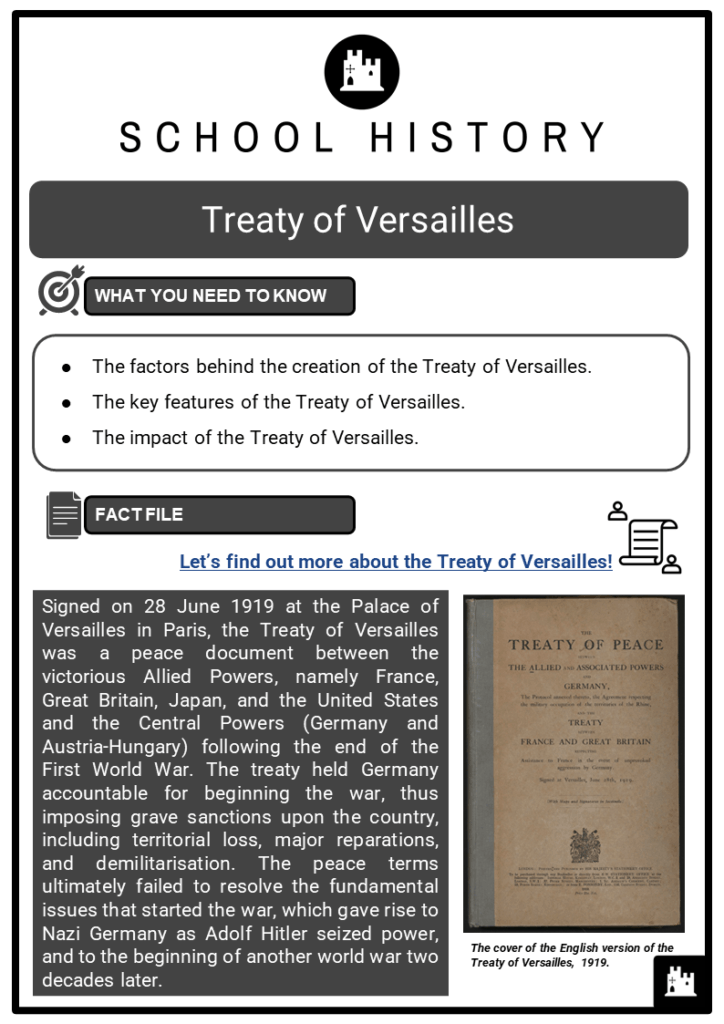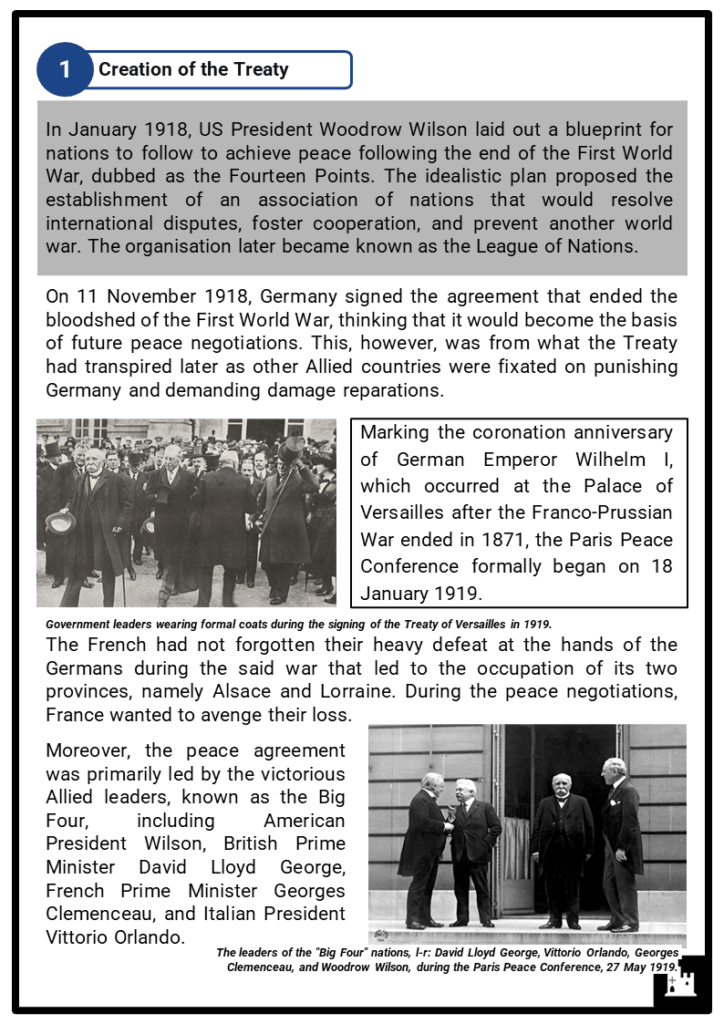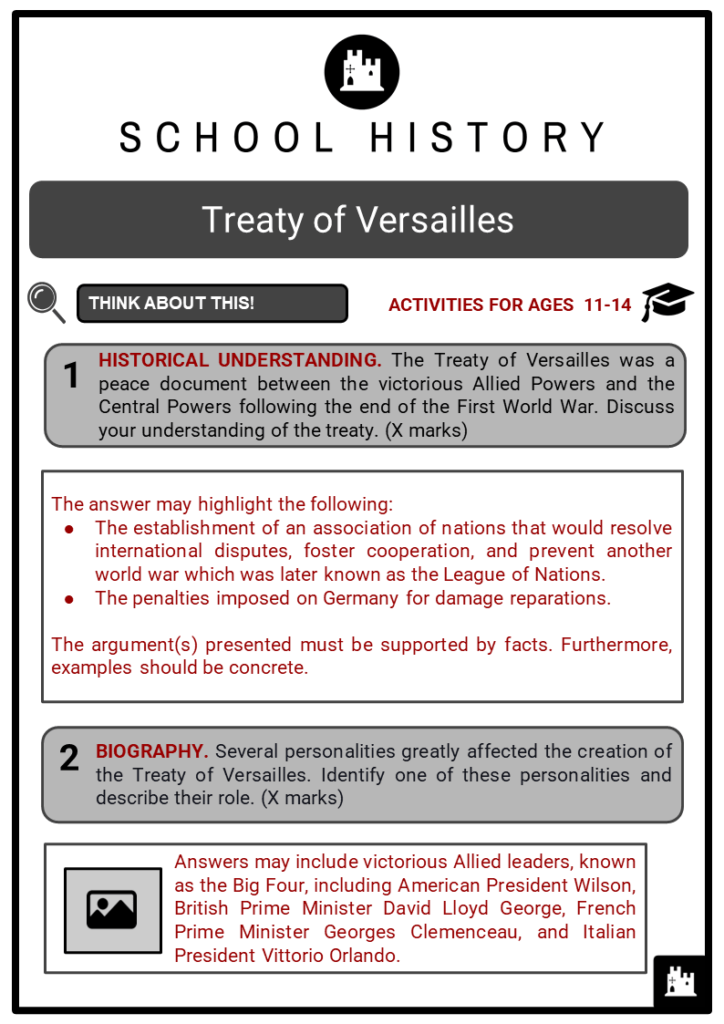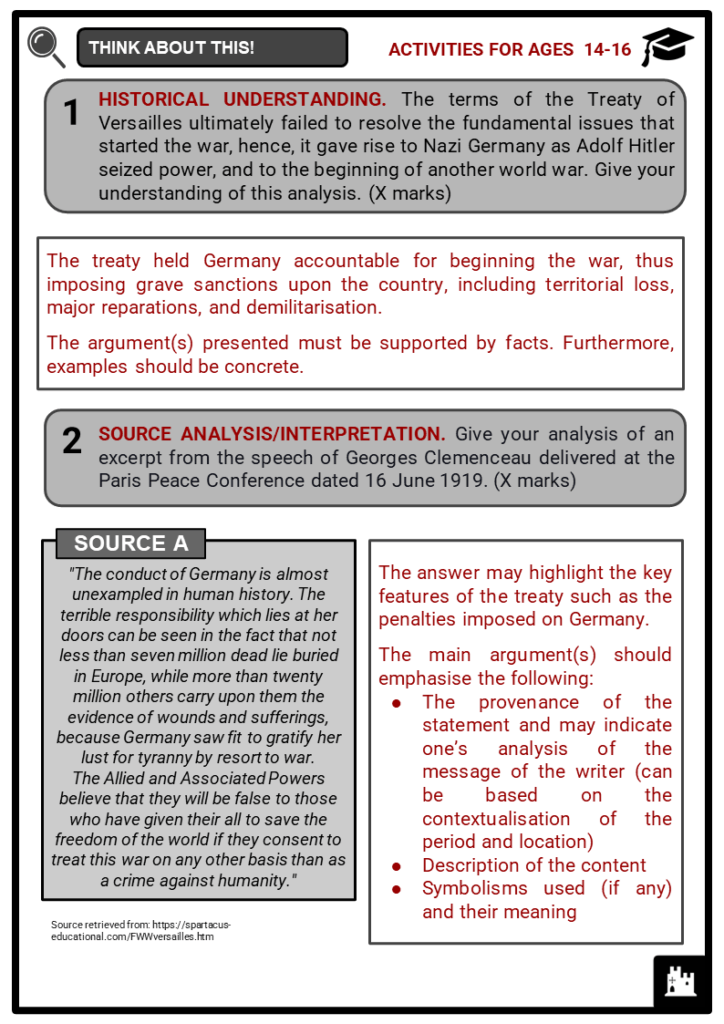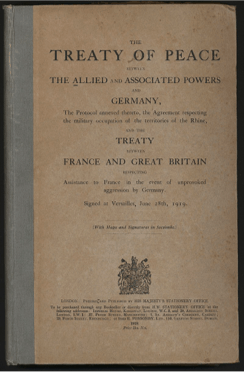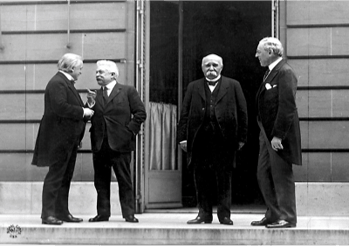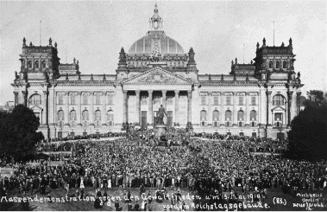Download Treaty of Versailles Worksheets
Do you want to save dozens of hours in time? Get your evenings and weekends back? Be able to teach Treaty of Versailles to your students?
Our worksheet bundle includes a fact file and printable worksheets and student activities. Perfect for both the classroom and homeschooling!
Table of Contents
Add a header to begin generating the table of contents
Summary
- The factors behind the creation of the Treaty of Versailles.
- The key features of the Treaty of Versailles.
- The impact of the Treaty of Versailles.
Key Facts And Information
Let’s find out more about the Treaty of Versailles!
- Signed on 28 June 1919 at the Palace of Versailles in Paris, the Treaty of Versailles was a peace document between the victorious Allied Powers, namely France, Great Britain, Japan, and the United States and the Central Powers (Germany and Austria-Hungary) following the end of the First World War. The treaty held Germany accountable for beginning the war, thus imposing grave sanctions upon the country, including territorial loss, major reparations, and demilitarisation. The peace terms ultimately failed to resolve the fundamental issues that started the war, which gave rise to Nazi Germany as Adolf Hitler seized power, and to the beginning of another world war two decades later.
Creation of the Treaty
- In January 1918, US President Woodrow Wilson laid out a blueprint for nations to follow to achieve peace following the end of the First World War, dubbed as the Fourteen Points. The idealistic plan proposed the establishment of an association of nations that would resolve international disputes, foster cooperation, and prevent another world war. The organisation later became known as the League of Nations.
- On 11 November 1918, Germany signed the agreement that ended the bloodshed of the First World War, thinking that it would become the basis of future peace negotiations. This, however, was from what the Treaty had transpired later as other Allied countries were fixated on punishing Germany and demanding damage reparations.
- Marking the coronation anniversary of German Emperor Wilhelm I, which occurred at the Palace of Versailles after the Franco-Prussian War ended in 1871, the Paris Peace Conference formally began on 18 January 1919.
- The French had not forgotten their heavy defeat at the hands of the Germans during the said war that led to the occupation of its two provinces, namely Alsace and Lorraine. During the peace negotiations, France wanted to avenge their loss.
- Moreover, the peace agreement was primarily led by the victorious Allied leaders, known as the Big Four, including American President Wilson, British Prime Minister David Lloyd George, French Prime Minister Georges Clemenceau, and Italian President Vittorio Orlando.
- Russia, another Allied Power until 1917, was not represented as well. However, the country’s new Bolshevik leadership had already made a separate peace with Germany and remained out of the conflict.
- Additionally, the Big Four leaders had their own vested interests during the peace conference. To protect another German occupation, Clemenceau demanded massive reparations from Germany, which was also a way to place the country in an economic disaster.
- Britain’s Lloyd George, meanwhile, emphasised the reconstruction and rebuilding of Germany to become a trading partner of the United Kingdom.
- Italy’s Orlando, on the other hand, demanded territorial expansion and influence for his country to become a world power, alongside the other strong nations.
- American President Wilson contradicted Italy’s demands for territorial expansion and proposed an ideal world order based on the Fourteen Points, which the other nations found difficult to put into policy.
- Ultimately, the treaty imposed harsh penalties upon Germany, such as the surrender of its many territories, massive reparations, demilitarisation, and war crime trials against Kaiser Wilhelm II and other German leaders.
- The most notable provision of the peace agreement was Article 231, known as the “war guilt clause”, stating that Germany accepts the entire responsibility for beginning the First World War, which most German people did not agree with.
Effects on the Central Powers
- After signing the Paris peace treaty, Germany was forced to surrender control of Alsace and Lorraine, two provinces of France seized by the Germans as part of the Prussian victory.
- France also attained its objective of occupying and making the German military forces leave Rhineland, a territory along the borders of Germany, which housed many of its industries. If the Germans resisted, France would invade their country.
- In addition to this, Germany needed to surrender most of its territories to then newly-established Poland, whose land also included old Russian and Austrian areas. The lands of Moresnet and Eupen and Malmedy, meanwhile, became part of Belgium.
- Austria-Hungary, on the other hand, was divided into many nations, separating the two in the process. The country’s former territories, namely Bosnia, Slovenia, and Croatia, were then added to northern Macedonia, part of old Bulgaria, and to Serbia and Montenegro to establish one new nation known as Yugoslavia. Some parts of Austria were given to Italy as well.
- The Treaty of Versailles likewise created other new countries, such as Czechoslovakia (from old Bohemia and Moravia), Estonia, Finland, Latvia, and Lithuania, among many others. Greece likewise took parts of Turkey, particularly Ionia in the western territory, and Constantinople. Other parts of Turkey were occupied by France and the United Kingdom. For this reason, Britain took control of Palestine, Iraq, and Transjordan (later divided into Israel, Iraq, and Jordan). Syria and Lebanon were placed under the French government.
Long-term problems
- Due to the massive reparations that Germany needed to pay following the Treaty of Versailles, the country suffered a cycle of hyperinflation from 1921 to 1923.
- Even though President Wilson represented the United States at the Paris Peace Conference, Congress still had to pass the agreement as indicated in the American law.
- However, given the presence of conservative Republicans and a majority of German-Americans, the Treaty of Versailles was never ratified by Congress. Still, France and Great Britain imposed their sanctions and demands upon Germany.
- As the Great Depression approached after 1929, the Weimar government collapsed, which resulted in Adolf Hitler’s rise to power, alongside the National Socialist German Workers' Party.
- Following this, Germany abolished the peace treaty, thereby declaring that the Germans would no longer uphold the reparations for the damages during the First World War.
- Furthermore, Hitler began establishing and developing the country’s military troops again. On 7 March 1936, German forces occupied the demilitarised Rhineland, essentially disregarding the peace accord. Hitler’s Nazi rule would eventually lead to the onset of the Second World War.
Image sources:

